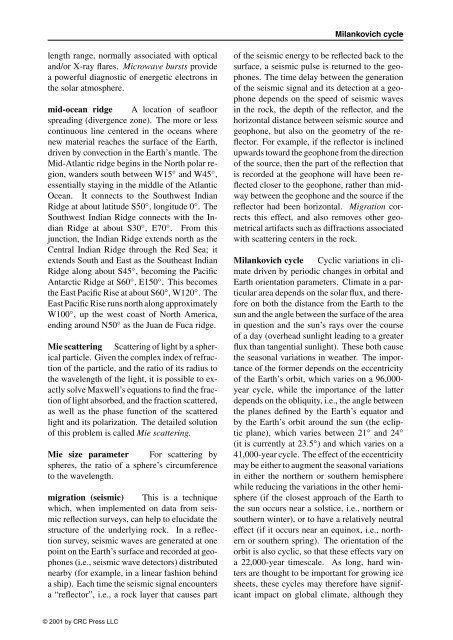DICTIONARY OF GEOPHYSICS, ASTROPHYSICS, and ASTRONOMY
DICTIONARY OF GEOPHYSICS, ASTROPHYSICS, and ASTRONOMY
DICTIONARY OF GEOPHYSICS, ASTROPHYSICS, and ASTRONOMY
You also want an ePaper? Increase the reach of your titles
YUMPU automatically turns print PDFs into web optimized ePapers that Google loves.
length range, normally associated with optical<br />
<strong>and</strong>/or X-ray flares. Microwave bursts provide<br />
a powerful diagnostic of energetic electrons in<br />
the solar atmosphere.<br />
mid-ocean ridge A location of seafloor<br />
spreading (divergence zone). The more or less<br />
continuous line centered in the oceans where<br />
new material reaches the surface of the Earth,<br />
driven by convection in the Earth’s mantle. The<br />
Mid-Atlantic ridge begins in the North polar region,<br />
w<strong>and</strong>ers south between W15 ◦ <strong>and</strong> W45 ◦ ,<br />
essentially staying in the middle of the Atlantic<br />
Ocean. It connects to the Southwest Indian<br />
Ridge at about latitude S50 ◦ , longitude 0 ◦ . The<br />
Southwest Indian Ridge connects with the Indian<br />
Ridge at about S30 ◦ , E70 ◦ . From this<br />
junction, the Indian Ridge extends north as the<br />
Central Indian Ridge through the Red Sea; it<br />
extends South <strong>and</strong> East as the Southeast Indian<br />
Ridge along about S45 ◦ , becoming the Pacific<br />
Antarctic Ridge at S60 ◦ , E150 ◦ . This becomes<br />
the East Pacific Rise at about S60 ◦ , W120 ◦ . The<br />
East Pacific Rise runs north along approximately<br />
W100 ◦ , up the west coast of North America,<br />
ending around N50 ◦ as the Juan de Fuca ridge.<br />
Mie scattering Scattering of light by a spherical<br />
particle. Given the complex index of refraction<br />
of the particle, <strong>and</strong> the ratio of its radius to<br />
the wavelength of the light, it is possible to exactly<br />
solve Maxwell’s equations to find the fraction<br />
of light absorbed, <strong>and</strong> the fraction scattered,<br />
as well as the phase function of the scattered<br />
light <strong>and</strong> its polarization. The detailed solution<br />
of this problem is called Mie scattering.<br />
Mie size parameter For scattering by<br />
spheres, the ratio of a sphere’s circumference<br />
to the wavelength.<br />
migration (seismic) This is a technique<br />
which, when implemented on data from seismic<br />
reflection surveys, can help to elucidate the<br />
structure of the underlying rock. In a reflection<br />
survey, seismic waves are generated at one<br />
point on the Earth’s surface <strong>and</strong> recorded at geophones<br />
(i.e., seismic wave detectors) distributed<br />
nearby (for example, in a linear fashion behind<br />
a ship). Each time the seismic signal encounters<br />
a “reflector”, i.e., a rock layer that causes part<br />
© 2001 by CRC Press LLC<br />
Milankovich cycle<br />
of the seismic energy to be reflected back to the<br />
surface, a seismic pulse is returned to the geophones.<br />
The time delay between the generation<br />
of the seismic signal <strong>and</strong> its detection at a geophone<br />
depends on the speed of seismic waves<br />
in the rock, the depth of the reflector, <strong>and</strong> the<br />
horizontal distance between seismic source <strong>and</strong><br />
geophone, but also on the geometry of the reflector.<br />
For example, if the reflector is inclined<br />
upwards toward the geophone from the direction<br />
of the source, then the part of the reflection that<br />
is recorded at the geophone will have been reflected<br />
closer to the geophone, rather than midway<br />
between the geophone <strong>and</strong> the source if the<br />
reflector had been horizontal. Migration corrects<br />
this effect, <strong>and</strong> also removes other geometrical<br />
artifacts such as diffractions associated<br />
with scattering centers in the rock.<br />
Milankovich cycle Cyclic variations in climate<br />
driven by periodic changes in orbital <strong>and</strong><br />
Earth orientation parameters. Climate in a particular<br />
area depends on the solar flux, <strong>and</strong> therefore<br />
on both the distance from the Earth to the<br />
sun <strong>and</strong> the angle between the surface of the area<br />
in question <strong>and</strong> the sun’s rays over the course<br />
of a day (overhead sunlight leading to a greater<br />
flux than tangential sunlight). These both cause<br />
the seasonal variations in weather. The importance<br />
of the former depends on the eccentricity<br />
of the Earth’s orbit, which varies on a 96,000year<br />
cycle, while the importance of the latter<br />
depends on the obliquity, i.e., the angle between<br />
the planes defined by the Earth’s equator <strong>and</strong><br />
by the Earth’s orbit around the sun (the ecliptic<br />
plane), which varies between 21 ◦ <strong>and</strong> 24 ◦<br />
(it is currently at 23.5 ◦ ) <strong>and</strong> which varies on a<br />
41,000-year cycle. The effect of the eccentricity<br />
may be either to augment the seasonal variations<br />
in either the northern or southern hemisphere<br />
while reducing the variations in the other hemisphere<br />
(if the closest approach of the Earth to<br />
the sun occurs near a solstice, i.e., northern or<br />
southern winter), or to have a relatively neutral<br />
effect (if it occurs near an equinox, i.e., northern<br />
or southern spring). The orientation of the<br />
orbit is also cyclic, so that these effects vary on<br />
a 22,000-year timescale. As long, hard winters<br />
are thought to be important for growing ice<br />
sheets, these cycles may therefore have significant<br />
impact on global climate, although they<br />
317
















